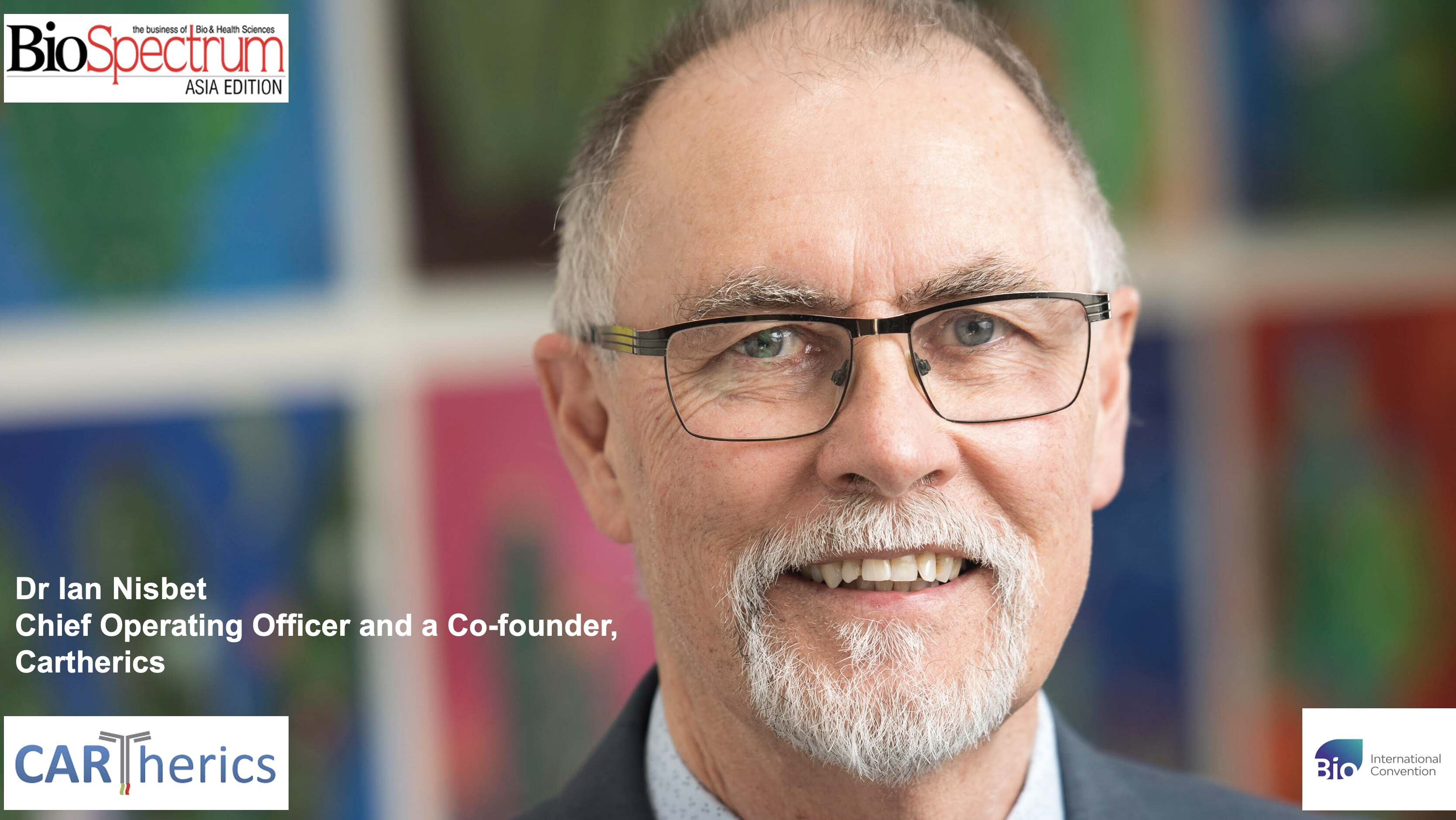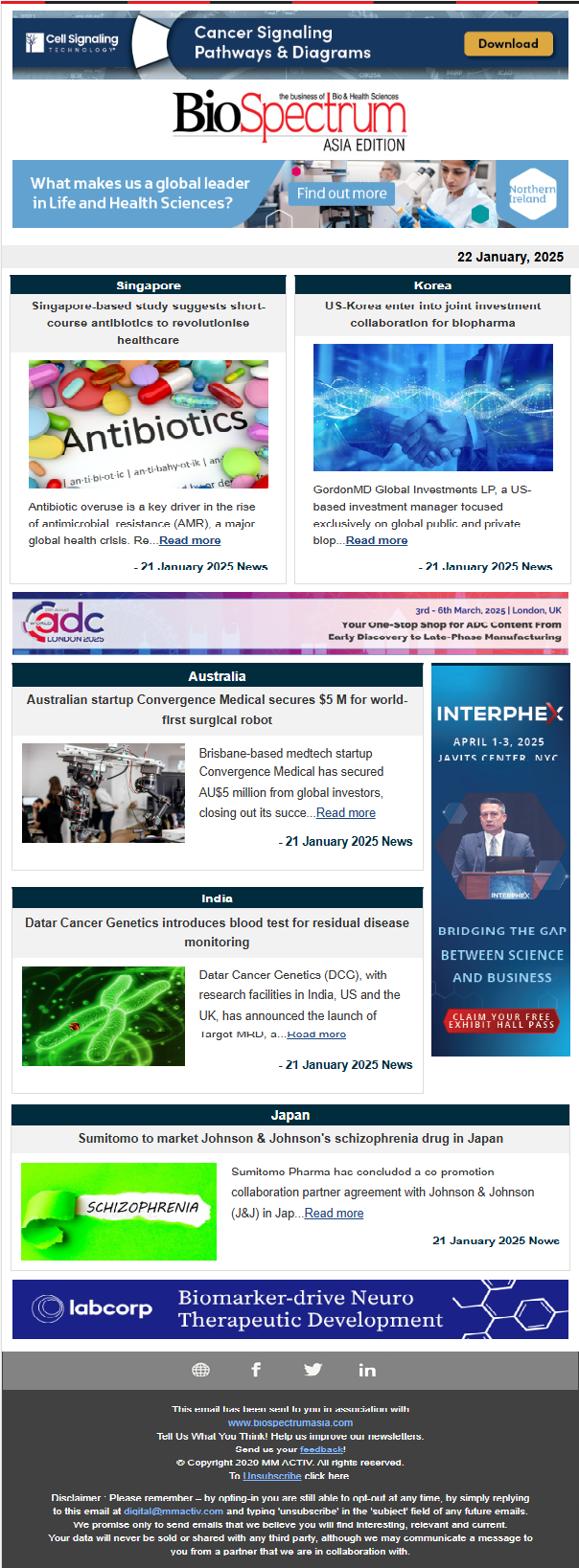
Dr Ian Nisbet, Chief Operating Officer and co-founder of Cartherics, brings over three decades of biotech leadership experience across Australia and the US.
In this exclusive interview with BioSpectrum Asia, Dr Nisbet discusses the dual applicability of Cartherics’ CAR-NK platform in cancer and endometriosis, regulatory pathways for cell therapies, and the company’s unique positioning in a challenging innovation climate. As Cartherics eyes strategic partnerships at BIO 2025, he emphasises resilience, adaptability, and scientific ingenuity as key drivers of the company’s journey.
Cartherics is developing CAR-NK cell therapies for cancer and endometriosis—two vastly different disease areas. What makes your platform adaptable across such diverse indications?
Actually, there are a number of areas of overlap between cancer (particularly ovarian cancer) and endometriosis. They are both associated with abnormal cell growth; immune cell deficiency or reduced function is part of the disease process for both; and patients with endometriosis are at increased risk of developing ovarian cancer. Also, importantly, the tumor markers that Cartherics is targeting with its CAR-NK cells, are expressed by some (in the case of TAG-72) and most (in the case of tissue factor, TF) endometrial cells of patients with endometriosis. Therefore, the CAR-NK products that Cartherics is developing for the treatment of cancer may also be suitable for the treatment of endometriosis. Cartherics’ initial clinical trial with its lead product, CTH-401, is aimed to establish the safety of the product when delivered intraperitoneally to ovarian cancer patients. This will support moving CTH-401 to clinical trials in endometriosis using the same route of administration, with reassurance that patient safety will not be compromised. In this way we’re able to leverage our development of CTH-401 in cancer to rapidly move into endometriosis as well.
Given your involvement in developing two FDA-approved oncology drugs, how does the current regulatory landscape compare for advanced cell therapies like those Cartherics is pursuing?
When we developed VELCADEÒ at Millennium, we took advantage of the FDA’s subpart H accelerated approval process. This enabled the company to save years in approval timeline and make the drug available to multiple myeloma patients in a timely manner after completing a single (but large) Phase II clinical trial. The FDA’s willingness to work with the company to make this life-changing drug available to patients as quickly as possible (while not compromising on patient safety) was commendable. It is reassuring that the accelerated approval pathway remains fundamentally unchanged, since it is an efficient way of bringing new oncology products to the market. At Cartherics, our clinical development plans incorporate accelerated approval as an integral part of our strategy to minimize development timelines and costs, balanced with assuring patient safety. Small companies like Cartherics do not have the resources to investigate the myriad of dose, schedule, combination therapy and patient populations that could be explored with a new cell therapy. The critical thing is to get an initial approval as quickly as possible and then let the product be explored by oncologists in the real-world setting. It is not clear yet what changes to the CGT regulatory environment at FDA will emerge from the new HHS administration; loss of key staff is concerning but suggestions that excessive regulatory hurdles may be removed is encouraging. The new FDA administration has also indicated that AI will be introduced into the regulatory review process. Hopefully this will help reduce timelines without affecting the quality of review.
Endometriosis remains underdiagnosed and underserved globally. How is Cartherics positioning its cell therapy approach to address this unmet need?
Endometriosis represents a large but poorly diagnosed and poorly treated patient population, with up to 10% of the female population being affected. Symptoms include fatigue, bloating, severe pelvic pain, painful periods and infertility. Current treatments include steroid therapy and analgesics. There are no approved treatments that address the underlying disease and the development pipeline is very thin. Cartherics has established that its CAR targets, TAG-72 and TF, may be expressed by endometriosis cells. It has demonstrated that CTH-501 (a CAR-NK cell targeting TF) is extremely effective in killing endometriosis organoids. While this only provides in vitro evidence of efficacy, when considered together with the excellent safety profile of NK cells (in clinical studies from other companies), it provides a strong argument for exploring CTH-501 in endometriosis. The company anticipates that the CTH-501 cells will be effective in destroying ectopic endometrial tissue, thereby modifying the underlying disease and, hopefully, reducing or eradicating disease symptoms (particularly pain).
What are some of the key scientific or manufacturing hurdles Cartherics has overcome in developing an “effectively unlimited supply” of CAR-NK cells?
The “unlimited supply” of Cartherics’ CAR-iNK cells is based on the company’s use of gene-edited iPSCs as the starting point for its manufacturing process. The iPSCs are pluripotent and are capable (in theory at least) of unrestricted propagation. Therefore, Cartherics has the capability to produce an inexhaustible and consistent supply of its CAR-iNK cells. However, the manufacturing process is a complex one and has presented a number of challenges for Cartherics to overcome. The key scientific hurdles have been developing efficient gene-editing processes, fully characterizing the gene-edited cells, and understanding how changes to the manufacturing process might impact the phenotype or function of the final NK cells. The key manufacturing hurdles have been associated with scale up of the manufacturing process and adapting it for use in a GMP environment. The method of manufacture (MoM) involves several steps of expansion and/or differentiation, with the cells progressing from adherent to non-adherent over the course of the process. Therefore, different types of culture vessels are required for the different steps. Cartherics has investigated multiple types of bioreactors in scaling up its method of manufacture (MoM) to be suitable for the supply of product for clinical trials, ultimately settling on vertical wheel bioreactor, cell-stack and G-Rex systems as most suitable for its purposes. Of the three, vertical wheel bioreactors present the most scalable option for manufacturing larger numbers of cells. Cartherics continues to explore options to simplify its MoM, increase product yield and reduce manufacturing costs.
As a biotech leader with over three decades of experience across Australia and the US, how do you see the innovation climate evolving—especially for smaller biotech firms pushing next-generation therapies?
The innovation climate for biotech companies is tough. Drug development is a long, risky and expensive business, requiring ongoing access to substantial amounts of risk capital. In the current economic and geopolitical environment, accessing capital is increasingly difficult. Venture capitalists and pharmaceutical companies are increasingly risk-averse and wanting human clinical data before investing, putting more pressure on biotechs to find other ways to fund their activities. The cycle of open and closed funding windows is nothing new for biotech; it just seems that, recently, the open windows are much shorter and shallower than what they have been in the past. A further big challenge for companies like Cartherics is that cell and gene therapies (CGTs) are not “flavor of the month” in the drug development sector at the moment. In oncology, the technologies that are currently attracting pharma (and therefore investor) interest are antibody drug conjugates (ADCs) and bi-specific antibodies. They are the hot areas to be in. This will change. It is always the case with new technologies – initial euphoria and enthusiasm that wanes when the inevitable teething problems arise; followed by a period of disinterest and skepticism; followed by resurgent interest when the problems are eventually solved; and often repeating over multiple cycles. I’ve seen it many times before over my career. It wasn’t all that long ago that ADCs and bi-specifics were out-of-favor technologies. Like them, the tide will turn (again) for CGTs. This will be driven by clinical results and, already we’re starting to see data emerging that supports the use of cellular therapies in solid tumors, which should re-kindle interest in the potential for CGTs in cancer. Two critical (but underappreciated) properties of successful biotech companies are resilience and perseverance. Without these qualities, no new technology would ever deliver the next generation of therapies. Cartherics aims to be one of the companies that perseveres and delivers on the promise of CGTs.
What do you hope to achieve at BIO this year—for Cartherics as well as in terms of broader partnerships or global visibility?
The primary purpose for attending BIO this year is to engage (or re-engage) with potential partners and investors. In doing so, we will be trying create enthusiasm for the CGT in general area while, at the same time, distinguishing Cartherics from the many other CGT players. We will be highlighting Cartherics’ technology platform for the generation of NK (and other immune) cells and EVs; our novel approaches for creating NK cells that are not switched off in the immunosuppressive tumor microenvironment (TME); and our exploration of underserved, intractable diseases like endometriosis and neurodegenerative disorders. We believe this combination of technology, products and indications makes Cartherics unique in the CGT field. Through our interactions at BIO, we hope to generate a number of strong leads for detailed follow-up discussions that will ultimately lead to important partnerships and/or investments. It is important to note that conferences like BIO are just part of an ongoing process in the life of a biotech company. Partnerships and investments are the outcome of a complex mixture of discussions, information sharing and negotiation within the context of the environment at a particular point in time. And, as is the case with many things, timing is essential to success. Even if we are unable to convince the parties with which we’re meeting at BIO that they should take a look at CGTs and Cartherics right now, we want them to have a connection with and awareness of Cartherics so we can quickly contact them again when the time is right.




